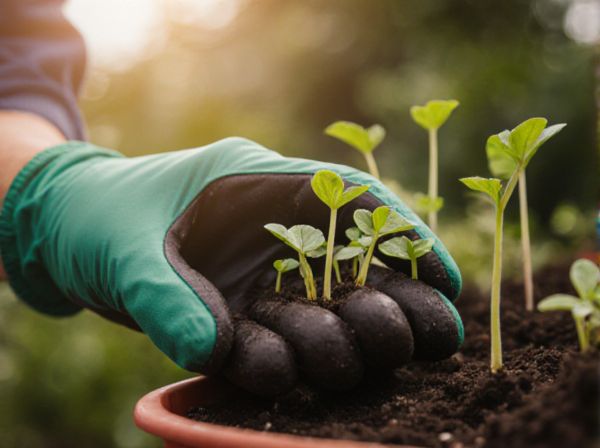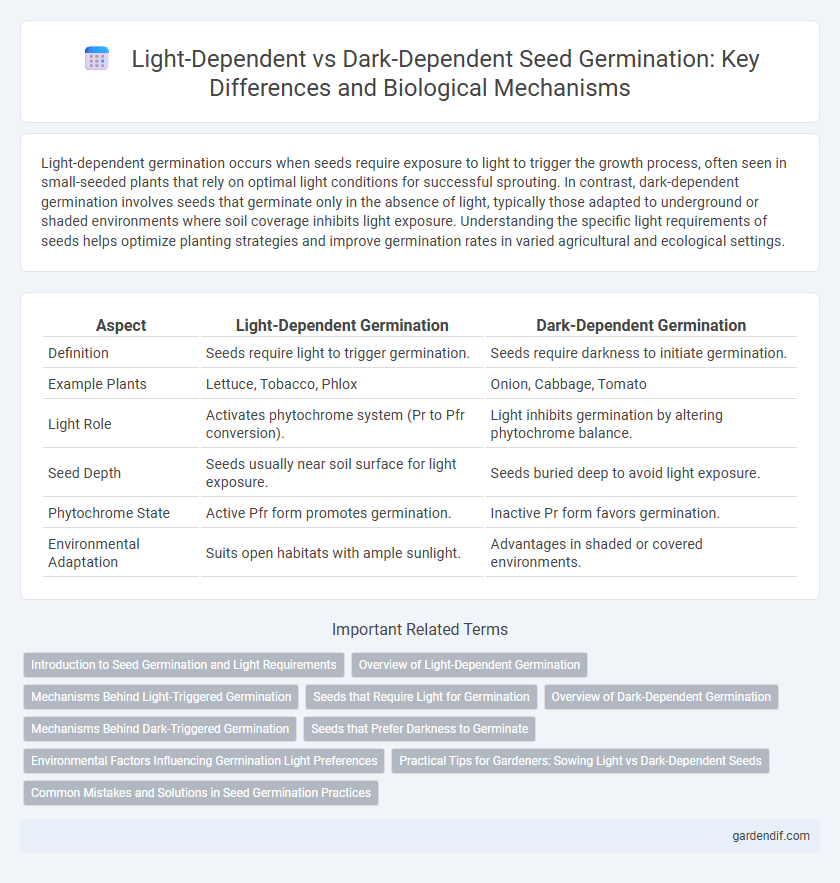
Light-Dependent Germination vs Dark-Dependent Germination Illustration
Light-dependent germination occurs when seeds require exposure to light to trigger the growth process, often seen in small-seeded plants that rely on optimal light conditions for successful sprouting. In contrast, dark-dependent germination involves seeds that germinate only in the absence of light, typically those adapted to underground or shaded environments where soil coverage inhibits light exposure. Understanding the specific light requirements of seeds helps optimize planting strategies and improve germination rates in varied agricultural and ecological settings.
Table of Comparison
| Aspect | Light-Dependent Germination | Dark-Dependent Germination |
|---|---|---|
| Definition | Seeds require light to trigger germination. | Seeds require darkness to initiate germination. |
| Example Plants | Lettuce, Tobacco, Phlox | Onion, Cabbage, Tomato |
| Light Role | Activates phytochrome system (Pr to Pfr conversion). | Light inhibits germination by altering phytochrome balance. |
| Seed Depth | Seeds usually near soil surface for light exposure. | Seeds buried deep to avoid light exposure. |
| Phytochrome State | Active Pfr form promotes germination. | Inactive Pr form favors germination. |
| Environmental Adaptation | Suits open habitats with ample sunlight. | Advantages in shaded or covered environments. |
Introduction to Seed Germination and Light Requirements
Seed germination is influenced by light conditions, where light-dependent seeds require exposure to specific wavelengths, particularly red light, to trigger the germination process, while dark-dependent seeds necessitate darkness or minimal light exposure to initiate growth. Phytochromes, the plant photoreceptors, play a crucial role in detecting light signals and regulating these germination responses. Understanding the light requirements of seeds is essential for optimizing germination rates in agricultural and horticultural practices.
Overview of Light-Dependent Germination
Light-dependent germination occurs when seeds require exposure to specific light wavelengths, primarily red light, to initiate the germination process. Phytochrome photoreceptors mediate this response by switching between active and inactive forms that regulate gene expression for seed metabolism and growth. This mechanism ensures that seeds germinate only when they are exposed to favorable environmental conditions, typically near the soil surface where light penetrates.
Mechanisms Behind Light-Triggered Germination
Photoreceptors such as phytochromes regulate light-dependent germination by detecting red and far-red light, triggering a signaling cascade that promotes seed coat loosening and embryo growth. Activation of phytochrome B converts Pr to Pfr, which enhances the expression of gibberellin biosynthesis genes, increasing gibberellin levels to stimulate seed germination. This mechanism contrasts with dark-dependent germination, where hormonal balance shifts differently, often involving higher abscisic acid levels that inhibit germination in the absence of light stimuli.
Seeds that Require Light for Germination
Seeds that require light for germination, such as lettuce and lettuce varieties, depend on specific wavelengths in the red and far-red spectrum to trigger the phytochrome system, which activates metabolic pathways essential for sprouting. These photoblastic seeds typically remain dormant in darkness and need exposure to light to initiate processes like enzyme activation, cell elongation, and energy production. Light-dependent germination ensures seedling emergence in optimal conditions, often preventing growth beneath soil or leaf litter where light penetration is insufficient.
Overview of Dark-Dependent Germination
Dark-dependent germination occurs when seeds require darkness to initiate the germination process, often observed in species adapted to buried or shaded environments. This type of germination relies on phytochrome photoreceptors that detect low light conditions, triggering hormonal changes that promote seed coat weakening and embryo growth. Understanding dark-dependent germination is crucial for optimizing seed sowing depth and improving crop establishment in agroecosystems.
Mechanisms Behind Dark-Triggered Germination
Dark-triggered germination relies on phytochrome-mediated signaling pathways that detect the absence of light, activating specific genes responsible for seedling growth. In darkness, phytochrome remains in its inactive Pr form, promoting the accumulation of hormones like gibberellins that break seed dormancy and initiate germination. This mechanism ensures seeds germinate underground or in shaded environments, optimizing survival by responding to environmental cues beyond light exposure.
Seeds that Prefer Darkness to Germinate
Seeds that prefer darkness to germinate, such as lettuce and tobacco, exhibit dark-dependent germination by requiring low light or complete absence of light to initiate sprouting. These seeds rely on phytochrome systems sensitive to light conditions, where exposure to light can inhibit gibberellin production, thus delaying germination. This adaptation ensures seedling emergence in environments like soil surfaces or beneath leaf litter, optimizing survival in shaded or covered habitats.
Environmental Factors Influencing Germination Light Preferences
Light-dependent germination relies on specific wavelengths, primarily red light, to trigger phytochrome activation, which initiates seed germination by signaling optimal environmental conditions. Dark-dependent germination occurs in seeds adapted to germinate under soil or leaf litter, where absence of light reduces phytochrome activity and promotes growth through alternative hormonal pathways. Environmental factors such as soil depth, canopy cover, and light quality crucially influence germination light preferences by altering the spectral composition and intensity of light reaching the seed.
Practical Tips for Gardeners: Sowing Light vs Dark-Dependent Seeds
Light-dependent seeds, such as lettuce and petunia, require exposure to light for optimal germination and should be sown on the soil surface without covering them with soil. Dark-dependent seeds, including beans and peas, need to be buried beneath the soil at the recommended depth to ensure darkness for successful sprouting. Gardeners can enhance germination rates by following species-specific guidelines on light exposure, maintaining consistent moisture, and providing appropriate temperature conditions.
Common Mistakes and Solutions in Seed Germination Practices
Common mistakes in light-dependent germination include inadequate exposure to light intensity or duration, resulting in poor seedling emergence, while dark-dependent germination errors often involve unintended light exposure that inhibits germination. Ensuring precise control of light conditions through regulated photoperiods and using opaque coverings for dark-dependent seeds can significantly improve germination rates. Monitoring seed type-specific requirements and employing calibrated growth chambers or controlled environments helps optimize germination success for both light-dependent and dark-dependent seeds.
Light-Dependent Germination vs Dark-Dependent Germination Infographic

 gardendif.com
gardendif.com